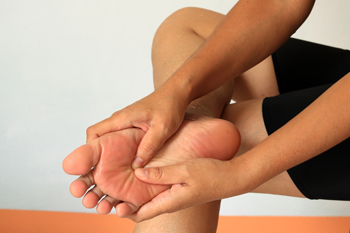Dallas (214) 340-8885
Athens (903) 677-9090
Gun Barrel City (903) 887-4341
Dallas (214) 340-8885
Athens (903) 677-9090
Gun Barrel City (903) 887-4341
 Peripheral artery disease (PAD) is a condition that causes reduced blood flow in the lower limbs. PAD is fairly common, particularly in older people, and is caused by a buildup of plaque along the walls of the arteries. The plaque makes the arteries narrow and harden, which makes it harder for blood to circulate to the lower limbs and provide the muscles with oxygen and nutrients. This leads to symptoms that include pain, achiness, fatigue, burning, muscle cramps, and overall discomfort in the feet and ankles. At first, these symptoms may just appear when you do more strenuous physical activities like walking uphill, walking for longer distances, or running. Eventually, however, the symptoms may worsen and appear after only a little bit of activity. You may also begin to experience numbness in your lower limbs when you are at rest. If you have symptoms of PAD, please seek the care of a podiatrist.
Peripheral artery disease (PAD) is a condition that causes reduced blood flow in the lower limbs. PAD is fairly common, particularly in older people, and is caused by a buildup of plaque along the walls of the arteries. The plaque makes the arteries narrow and harden, which makes it harder for blood to circulate to the lower limbs and provide the muscles with oxygen and nutrients. This leads to symptoms that include pain, achiness, fatigue, burning, muscle cramps, and overall discomfort in the feet and ankles. At first, these symptoms may just appear when you do more strenuous physical activities like walking uphill, walking for longer distances, or running. Eventually, however, the symptoms may worsen and appear after only a little bit of activity. You may also begin to experience numbness in your lower limbs when you are at rest. If you have symptoms of PAD, please seek the care of a podiatrist.
Peripheral artery disease can pose a serious risk to your health. It can increase the risk of stroke and heart attack. If you have symptoms of peripheral artery disease, consult with Dr. Jonathan Kletz from Texas Foot Works. Our doctor will assess your condition and provide you with quality foot and ankle treatment.
Peripheral artery disease (PAD) is when arteries are constricted due to plaque (fatty deposits) build-up. This results in less blood flow to the legs and other extremities. The main cause of PAD is atherosclerosis, in which plaque builds up in the arteries.
Symptoms
Symptoms of PAD include:
It is important to note that a majority of individuals never show any symptoms of PAD.
Diagnosis
While PAD occurs in the legs and arteries, Podiatrists can diagnose PAD. Podiatrists utilize a test called an ankle-brachial index (ABI). An ABI test compares blood pressure in your arm to you ankle to see if any abnormality occurs. Ultrasound and imaging devices may also be used.
Treatment
Fortunately, lifestyle changes such as maintaining a healthy diet, exercising, managing cholesterol and blood sugar levels, and quitting smoking, can all treat PAD. Medications that prevent clots from occurring can be prescribed. Finally, in some cases, surgery may be recommended.
If you have any questions, please feel free to contact one of our our offices located in Dallas, Athens, and Gun Barrel City, TX . We offer the newest diagnostic and treatment technologies for all your foot care needs.
Make sure you enter all the required information, indicated by an asterisk (*). HTML code is not allowed.